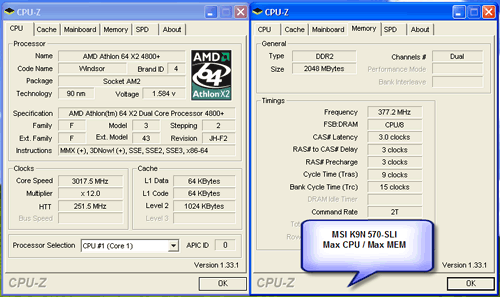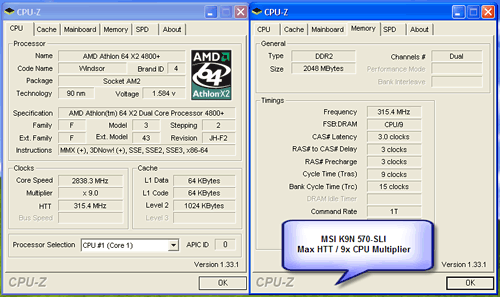NVIDIA nForce 500: Biostar and MSI Aim for the Gold
by Gary Key on June 8, 2006 4:30 AM EST- Posted in
- Motherboards
CPU/HTT Overclocking Results

This board is a good overclocker although it seemed to become unstable very quickly when pushed beyond its limits. For example, the board was extremely stable at 12x251HTT setting but this stability trailed off quickly and at 12x255HTT the board would no longer boot.
We did notice in our overclocking testing the board was very sensitive to memory settings and seemed to perform better with the memory between DDR2-667 and DDR2-800 at faster timings than increasing the memory speeds up to DDR2-1000 with relaxed timings.

The ability to hit and remain stable at 9x315HTT would normally be a joyous event but after the results of our Biostar board this result seems normal now. The ability of a board to exceed 300HTT and maintain excellent stability is now expected for a performance oriented board and MSI delivers in this case.
Memory Stress Testing
Memory stress tests look at the ability of the MSI K9N-SLI Platinum to operate at the officially supported memory frequencies of 800MHz DDR2 at the best performing memory timings the Corsair Twin2X2048-8500C5 revision will support.
The MSI board was very stable with two (1GB) DDR2 modules in Dual-Channel mode at the settings of 3-3-3-8 2T at 2.1V. The board would set 5-5-5-15 2T if the memory selection was left on auto. We did not notice any issues throughout our testing with our settings provided the voltage was set to 2.1V. Unlike the Biostar board we were unable to run the board at DDR2-667 with 1T timings in a stable fashion.
With four (1GB) Corsair modules in all four available memory slots, the MSI board was completely stable in Dual-Channel operation at the settings of 3-4-4-9 2T with the voltage set at 2.1V. Driving 4 DIMMs is much more stressful on the memory subsystem than the more common 2 DIMM configuration. These are very good results and the board performed admirably throughout our memory testing regimen that included eight to twelve hour runs of MemTest86, Prime95, and our benchmarks suites along with numerous iterations of SuperPI set at 32m.
| MSI K9N SLI Platinum | |
| Processor: | AMD Athlon 64 X2 - 4800+ (AM2) |
| Chipset: | nForce 570SLI |
| CPU Voltage: | 1.600V (1.300V default) |
| Memory Settings: | 3-3-3-9 2T 12x Multiplier 3-3-3-9 1T 9x Multiplier |
| DDR2 Results: | 12 x 251HTT = DDR2 754 9 x 315HTT = DDR2 631 |
| HT Multiplier: | 5x below 300HTT, 4x above 300HTT |
| Memory Voltage: | 2.3V |
| Chipset Voltage: | Auto |
| HT Voltage: | Auto |
| Cooling: | Zalman CNPS9500 AM2 |
| Power Supply: | OCZ GamexStream 700W |
| Maximum CPU OverClock: | 251HTT x 12 (3017MHz) +25% |
| Maximum FSB OverClock: | 315HTT x 9 (2838MHz) +57% |

This board is a good overclocker although it seemed to become unstable very quickly when pushed beyond its limits. For example, the board was extremely stable at 12x251HTT setting but this stability trailed off quickly and at 12x255HTT the board would no longer boot.
We did notice in our overclocking testing the board was very sensitive to memory settings and seemed to perform better with the memory between DDR2-667 and DDR2-800 at faster timings than increasing the memory speeds up to DDR2-1000 with relaxed timings.

The ability to hit and remain stable at 9x315HTT would normally be a joyous event but after the results of our Biostar board this result seems normal now. The ability of a board to exceed 300HTT and maintain excellent stability is now expected for a performance oriented board and MSI delivers in this case.
Memory Stress Testing
Memory stress tests look at the ability of the MSI K9N-SLI Platinum to operate at the officially supported memory frequencies of 800MHz DDR2 at the best performing memory timings the Corsair Twin2X2048-8500C5 revision will support.
| MSI K9N-SLI Platinum Stable DDR2-800 Timings - 2 DIMMs (2/4 slots populated - 1 Dual-Channel Bank) |
|
| Clock Speed: | 200MHz |
| Timing Mode: | 800MHz - Default |
| CAS Latency: | 3 |
| RAS to CAS Delay: | 3 |
| RAS Precharge: | 3 |
| RAS Cycle Time: | 8 |
| Command Rate: | 2T |
| Voltage: | 2.1V |
The MSI board was very stable with two (1GB) DDR2 modules in Dual-Channel mode at the settings of 3-3-3-8 2T at 2.1V. The board would set 5-5-5-15 2T if the memory selection was left on auto. We did not notice any issues throughout our testing with our settings provided the voltage was set to 2.1V. Unlike the Biostar board we were unable to run the board at DDR2-667 with 1T timings in a stable fashion.
| MSI K9N-SLI Platinum Stable DDR2-800 Timings - 4 DIMMs (4/4 slots populated - 2 Dual-Channel Banks) |
|
| Clock Speed: | 200MHz |
| Timing Mode: | 800MHz - Default |
| CAS Latency: | 3 |
| RAS to CAS Delay: | 4 |
| RAS Precharge: | 4 |
| RAS Cycle Time: | 9 |
| Command Rate: | 2T |
| Voltage: | 2.1V |
With four (1GB) Corsair modules in all four available memory slots, the MSI board was completely stable in Dual-Channel operation at the settings of 3-4-4-9 2T with the voltage set at 2.1V. Driving 4 DIMMs is much more stressful on the memory subsystem than the more common 2 DIMM configuration. These are very good results and the board performed admirably throughout our memory testing regimen that included eight to twelve hour runs of MemTest86, Prime95, and our benchmarks suites along with numerous iterations of SuperPI set at 32m.










17 Comments
View All Comments
dougcook - Friday, September 8, 2006 - link
I bought one of the MSI 570 boards (after reading this review). Everything seemed ok (some things seemed a bit cheap, but nothing really unusual). I got it all installed and running...For one day.
While burning a few CDs, the Northbridge overheated and the machine turned itself off. This happened 2 more times, and then the machine failed to boot at all (even after giving it time to cool off). I wasn't overclocking, and the box had decent ventilation.
This may not happen for everybody, but looking on NewEgg, it seems that this has happened to many other people. The MSI northbridge does not have an adequate heatsink and is likely to burn up. Save the time and get something better. I got the equivalent ABit 570 motherboard, and I've been very happy so far. I hear good things about the ASUS 570 as well.
MacGuffin - Wednesday, June 21, 2006 - link
I don't mean to be a whiny biyatch but where's the follow-up article? Are you guys playing around with Conroe motherboards and ES chips again?;-)JakeBlade - Friday, June 9, 2006 - link
Northbridge fans blow. No pun intended.Visual - Friday, June 9, 2006 - link
in the comparison table on page 2, you have incorectly listed a firewire, 6 usb ports and 2 esata ports for the MSI. it doesn't have those, just 4 usbs. it does have a COM and LPT ports that you need to list though.Gary Key - Friday, June 9, 2006 - link
The right table was inserted this time, thanks!!!! :)A554SS1N - Friday, June 9, 2006 - link
I'm interested in the MSI K9N 550 chipset, but noticed this 570 SLi chipset has the same sized passive cooler; could you tell me what the temperatures for the chipet on load are? (Sometimes SpeedFan might be needed to detect them on some boards?).Gary Key - Friday, June 9, 2006 - link
I will see if we can get an accurate internal chipset temperature for you. The heatsink itself was at 56c under load when measured with a infrared device.A554SS1N - Thursday, June 15, 2006 - link
Thanks, I could get an idea that it may be upto 70C internal from that external heatsink reading.R3MF - Thursday, June 8, 2006 - link
sorry, not buying.give me the 8x/16x SLI split, as well as 8x slot, two 1x slots, and a couple of PCI slots that i can ignore.
then i'll buy.
segagenesis - Thursday, June 8, 2006 - link
... is its AMD. After reading about Conroe I would hope nVidia does this for the Intel camp now that I'd rather buy one of those than AM2.